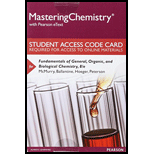
(a)
Interpretation:
The molecular formula of thalidomide is to be determined.
Concept introduction:
Molecular formula of a compound indicates the numbers of all the elements present in a molecule.
(b)
Interpretation:
The positions of all multiple bonds in the given structure of thalidomide are to be shown.
Concept introduction:
Covalent bonds are formed by sharing of electrons between atoms.
The valence electrons of Carbon are 4 electrons (requires 4 electrons to achieve octet).
The valence electrons of Oxygen are 6 electrons (requires 2 electrons to achieve octet).
The valence electrons of Hydrogen are 1 electron.
The valence electrons of Nitrogen are 5 electrons (requires 3 electrons to achieve octet).
The sharing of one electron from two atoms constitutes a single bond between the two atoms. The sharing of two electrons from two atoms constitutes a double bond between the two atoms.
(c)
Interpretation:
The geometry around the each carbon atoms and nitrogen atom of the thalidomide are needed to be determined.
Concept introduction:
Molecular geometry can be predicted from the structure by using the valence-shell Electron-pair repulsion (VSEPR) model.
-Count the number of valence electron pairs (bond pairs and lone pairs).
-Assume that the valence electron pairs form a structure that allows them to be as far away from each other as possible.
-If there are only two bond pair electrons, the molecule is linear.
-If there are three bond pair electrons, the molecule is shaped like a trigonal planar.
-If there are four bond pair electrons, the molecule is shaped as a regular tetrahedral.
- Repulsion between lone pair-bond pair of electrons effect the geometry of molecules.
Want to see the full answer?
Check out a sample textbook solution
Chapter 4 Solutions
Mastering Chemistry with Pearson eText -- Standalone Access Card -- for Fundamentals of General, Organic, and Biological Chemistry (8th Edition)
- Which of the following define the stereochemistry of alanine (as per the structure shown)? Note: Functional groups arranged horizontally are facing towards the front, and the functional groups arranged vertically are facing towards the back. a) d- b) S- c) R- d) I-arrow_forwardWhy is it not possible to find a five-fold symmetry operation in naturally-occurring crystals?arrow_forwardDraw condensed structural formulas for the two carboxylic acids with the molecular formula C4H8O2arrow_forward
- Following are two structural formulas for (S)-serine, one of the building blocks of proteins Is (S)-serine better represented by structural formula A or B?arrow_forwardWhat structures are labeled 1 in the diagrams? What structure is labeled 2 in the diagrams? What is labeled 3 in both diagrams? What is labeled 4 in the diagrams? What is labeled 5 in the diagrams?arrow_forwardIt is speculated that, in 1954, the scientist Allan Turing (who was instrumental in decoding the German Enigma code during the Second World War) ate an apple, which had been injected with a solution of cyanide, to commit suicide. How does cyanide poisoning work on a molecular level, and why can this type of toxic effect not be prevented as in the case of methanol poisoning?arrow_forward
- Use Frost Circles to complete the molecular orbital diagram for cyclooctatetrane. Label the bonding, non bonding, and anti bonding MO’s. If the molecule is planar, would it be aromatic, antiaromatic, or nonaromatic? If the molecule is nonplanar, would it be aromatic, antiaromatic, or nonaromatic?arrow_forwardWhen Alfred Werner was developing the field of coordination chemistry, it was argued by some that the optical activity he observed in the chiral complexes he had prepared was due to the presence of carbon atoms in themolecule. To disprove this argument, Werner synthesized a chiral complex of cobalt that had no carbon atoms in it, and he was able to resolve it into its enantiomers. Design a cobalt(III) complex that would be chiral if it could be synthesized and that contains no carbon atoms.arrow_forwardWhat is the “octet rule” and its biologically important exception?arrow_forward
 Principles Of Radiographic Imaging: An Art And A ...Health & NutritionISBN:9781337711067Author:Richard R. Carlton, Arlene M. Adler, Vesna BalacPublisher:Cengage Learning
Principles Of Radiographic Imaging: An Art And A ...Health & NutritionISBN:9781337711067Author:Richard R. Carlton, Arlene M. Adler, Vesna BalacPublisher:Cengage Learning
